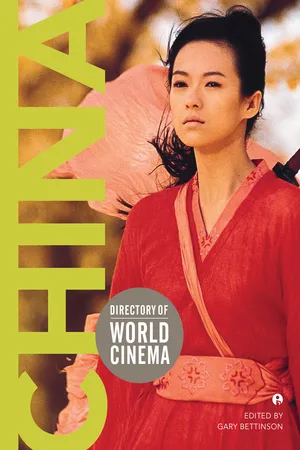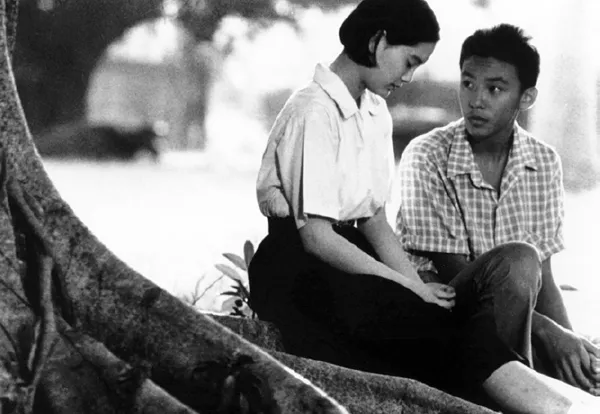![]()
A Brighter Summer Day
Gu ling jie shao nian sha ren shi jian
Studio/Distributor:
ICA
Jane Balfour Films
Yang & His Gang Filmmakers/
Cine Qua Non Films
MK2 Diffusion
Director:
Edward Yang
Producer:
Yang Yu Weiyan
Screenwriters:
Edward Yang
Lai Mingtang
Hung Hung
Alex Yang
Cinematographers:
Li Huigong
Zhang Longyu
Art Director:
Yang Yu Weiyan
Editor:
Chen Bo-Wen
Duration:
228 minutes
Genre:
Youth-gang drama
Cast:
Zhang Zhen
Zhang Guozhu
Lisa Yang
Lin Hongming
Alex Yang
Year:
1991
Synopsis
The year is 1960, when people in Taiwan have fresh memories of the mass exodus a decade earlier from Mao Zedong’s newly triumphant communist regime. Brought up in the resulting atmosphere of instability and uncertainty, many adolescents turn to street gangs as an outlet for anxiety and hostility. One such is teenager Xiao Si’r, who starts hanging around with the Little Park Gang because he has a crush on Ming, an older girl whose lover, Honey, led the group until he went on the lam after a murder. Honey comes out of hiding just long enough to be killed by Shandong, the kingpin of the rival 217 crew, whereupon Ming becomes even more promiscuous, Si’r grows increasingly confused, and the Little Park Gang lusts for revenge. An important subplot shows Zhang Ju, the father whose bland guidance Si’r has always ignored, being harassed and arrested for alleged links with the communist underground that this timid family man would never have dared to establish.
Critique
A Brighter Summer Day begins with a printed reminder of the huge migration that brought some two million Chinese refugees to Taiwan as the Chinese Civil War turned from a shooting war to a cold war in 1949. Having escaped from Mao Zedong’s revolutionary China, the immigrants found themselves in an equally oppressive environment under the martial law imposed by Chiang Kai-shek; but they quickly adapted, and while native-born citizens still made up 85 per cent of Taiwan’s population, the newcomers acquired disproportionate power through channels provided by Chiang’s government. Edward Yang was a little boy during this period, but he understood the immigrant situation well, since he had arrived in Taiwan as a child when his father fled Shanghai’s new communist regime. Like such New Taiwanese Cinema colleagues as Hou Hsiao-hsien and Chen Kun-ho, he began making films a few years after Chiang’s death in 1975, when the government was slowly liberalizing its policies.
Taking its story from Taiwan’s first juvenile murder case, involving a boy and girl in their early teens, A Brighter Summer Day depicts the coming-of-age challenges faced by immigrants’ children who found street gangs a readily available tool for carving out identities in an anxious and uncertain society. Two such outfits propel much of the action: the Little Park Gang, whose members come from immigrant households, and the 217 Gang, made up of kids from native Taiwanese families. The main character is Xiao Si’r, a promising 14-year-old whose chances for a good education and successful career are undermined by a deep immaturity where elders and authorities are concerned. The intricate plot follows his relationship with a variety of people including Zhang Ju, his chronically submissive father, and Ming, a promiscuous girl whose boyfriend ran the Little Park Gang until he killed a rival and went into hiding. Other characters range from school and police authorities to gang members whose nicknames – Sex Bomb, Headlights, Baldie, Animal, Underpants – would ring equally true in a Hollywood mafia movie.
A Brighter Summer Day, Yang & His Gang/The Kobal Collection.
These kids probably know a thing or two about American mobsters, since influences, artifacts, and social patterns from many international sources come into their lives, presaging the globalized culture that would blossom later in the twentieth century. Honey took to reading foreign novels during a stretch in jail, and wishes he had paid attention in school so that he could now write stories about his own experiences. Characters often run across objects left behind when Japan ended its bygone occupation of China, and samurai swords play a deadly role in the film’s climactic bloodbath. And everyone is mad for American popular music, which members of the Little Park crew sing at dances and entertainments. The movie’s Chinese title has been translated as ‘The Boy in the Murder Incident on Guling Street’, but the film takes its more resonant English-language title from the 1960 recording of ‘Are You Lonesome Tonight?’ by Elvis Presley, which gets Si’r and his sister puzzling over a phrase in the lyrics that might be ‘a brighter summer day’ or ‘a bright uh-summer day.’ The question is trivial, of course, but it is fascinating that a hooligan like Si’r really cares.
With almost 100 characters and a running time just shy of four hours, A Brighter Summer Day is a remarkable feat for Yang, who made it at a time when heightened competition from Hong Kong and Hollywood was dislodging the Taiwanese New Wave from public favour. Filmed in dark and brooding tones, it marks Yang’s shift to a more contemplative visual style marked by lengthy takes and relatively distant camera positions that emphasize relationships and environments over individual emotion and psychology. Regrettably, though, complexity and objectivity have played against widespread popularity. Its lofty reputation notwithstanding, A Brighter Summer Day is a film more written about than seen.
David Sterritt
Café Lumière
Kōhī jikō
Studios:
Shochiku
Asahi Shimbunsha
Sumitomo Corporation
Eisei Gekijo
Imagica Corp
Distributor:
Shochiku
Director:
Hou Hsiao-hsien
Producers:
Liao Ching-Song
Hideji Miyajima
Fumiko Osaka
Ichirō Yamamoto
Screenwriters:
Hou Hsiao-hsien Chi T’ien-wen
Cinematographer:
Mark Lee Ping-bing
Art Director:
Toshiharu Aida
Editor:
Liao Ching-Song
Duration:
105 minutes
Genre:
Drama
Cast:
Yo Hitoto
Tadanobu Asano
Masato Hagiwara
Kimiko Yo
Nenji Kobayashi
Year:
2003
Synopsis
Yōko is a young Japanese woman researching the life and work of a Taiwanese composer. When not working she spends time with a friend, Hajime, who records the sounds of Japan’s trains and railways and who runs a bookstore. Whilst visiting her parents Yoko tells her mother that she is pregnant by her Taiwanese boyfriend but that she intends to bring up her child by herself, which seems to displease the mother. Later, Yoko tells Hajime a frightening dream she has had and he procures for her a fairy tale that seems to resemble it; and as she conducts further research she feels the effects of her pregnancy. In addition, this matter continues to agonize her parents.
Critique
The opening moments of Café Lumière, Hou Hsiao-hsien’s fifteenth feature and first produced entirely outside Taiwan, resound with the quiet, contemplative sensibility that has come to define Hou’s work as thoroughly as that of the Japanese master Yasujiro Ozu, for whose centenery this project was commissioned (by the major Japa...


